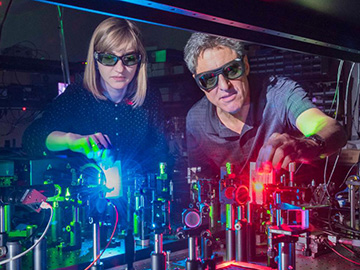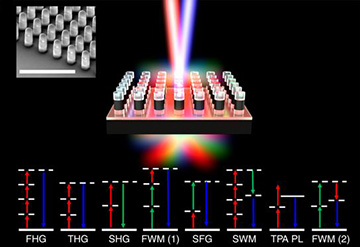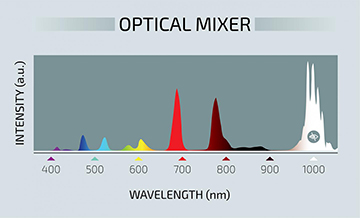
Sandia postdoc and co-lead author Polina Vabishchevich (left) and team leader Igal Brener in the lab. [Image: Randy Montoya/Sandia National Laboratories]
Researchers at Sandia National Laboratories, USA, and Friedrich Schiller University Jena, Germany, have demonstrated an optical frequency “metamixer” that can convert two input laser pulses into output light waves in eleven separate colors, from the UV to the near-IR (Nat. Commun., doi: 10.1038/s41467-018-04944-9). The business end of the device is a gallium arsenide metasurface, carefully designed to press into service seven separate nonlinear processes, ranging from second-harmonic generation to six-wave mixing, at the same time.
The team still has work to do to boost the device’s conversion efficiency and output power. Still, the researchers believe that with those improvements, their ultracompact mixer platform could “enable a plethora of applications in biology, chemistry, sensing, communications, and quantum optics.”
Current limitations
Frequency mixers are a core technology in radio-frequency communications, navigation and signal processing. They’re also common at optical wavelengths, with application examples ranging from attosecond-pulse and supercontinuum generation to the lowly green laser pointer.
Typically, optical frequency mixers rely on nonlinear optical processes and use bulk birefringent crystals to do the work. But mixers employing these crystals can generally produce only one new color of light at a given moment, because efficient frequency conversion requires phase matching between the input and output frequencies inside the nonlinear medium. As a practical matter, that limits conventional nonlinear optical mixers to one nonlinear process at a time and to operation in a narrow bandwidth, with dodgy physical alignment of the nonlinear crystal needed to tune output wavelengths.
Metasurfaces for multiple nonlinearities
The research team, led by OSA Fellow Igal Brener at Sandia, sought to create a much more versatile mixer by tapping the strengths of gallium arsenide, a material known to have large nonlinear coefficients. In particular, they did an end run around the phase-matching requirement by engineering the material at the nanoscale, where the tight confinement of light in subwavelength cavities can significantly enhance field strengths. Those strong fields, in turn, allow efficient frequency conversion with less need for phase matching—and the potential to tap multiple nonlinear processes at the same time.

Schematic of an optical metamixer, with inset photomicrograph of the surface (scale bar: 3 microns) and schematic energy diagrams of the seven nonlinear processes that create eleven output wavelengths. [Image: Adapted from S. Liu et al., Nat. Commun. 9, 2507 (2018); CC BY 4.0 (https://creativecommons.org/licenses/by/4.0/)]
To create the platform, the researchers used electron-beam lithography and inductively coupled plasma etching to fashion a forest of 400-nm-diameter nanocylinders consisting of three layers: a 300-nm-thick silicon-oxide etch mask at the top, a 450-nm-thick gallium arsenide nanodisk, and a 400-nm-thick, low-refractive-index aluminum-gallium oxide layer on the bottom. These nanocylinders were laid out in a rectilinear array, with a separation distance of around 840 nm, atop a high-index layer of gallium arsenide.
From two wavelengths to eleven
With their sample in hand, the researchers next fired two near-IR femtosecond laser beams simultaneously at the material—one with a wavelength of 1.57 microns, near the metamaterial’s calculated magnetic-dipole resonance, and one at 1.24 microns, to overlap with the electric-dipole resonance. They focused the two beams on the same roughly 3-micron-diameter spot, and measured the resulting output signal with a liquid-nitrogen-cooled silicon camera fitted to a spectrometer.
The team’s experiments showed that the metamixer surface converted the two IR pulses into output waves with eleven spectral peaks, ranging from 380 nm to 1000 nm. Numerical modeling revealed that the eleven colors were generated by combinations of seven separate nonlinear processes: second-, third- and fourth-harmonic generation, sum-frequency generation, two-photon absorption-induced photoluminescence, and four- and six-wave mixing.
Broad application space

The metamixer produced light in eleven separate colors from two input near-IR pulses. [Image: Infographic by Michael Vittitow]
Right now, the conversion efficiencies of the material are rather low—in part because most of the nonlinearly generated frequencies are above the gallium arsenide band gap and thus are largely absorbed by the material. The team believes that it can boost those efficiencies by experimenting with larger-band-gap materials and by tweaking the nanoresonator dimensions, shapes and orientations.
As those efforts bear fruit, the researchers see a broad application space for the ultracompact optical mixers that the work could enable. These could include laser sources for the mid-IR part of the spectrum, the generation of higher-order harmonics for new approaches to attosecond-pulse generation, and compact light sources at specific wavelengths for biomedical imaging, remote sensing, communications and more.
